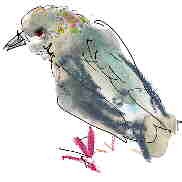yahoo.ca
yahoo.ca |
| Pleomorphism |
see also: *darkfield
microscopy/ |
| "Pleomorphism" is the term used to discribe the fact that some microorganisms can change form. At its most conservative scientists discovered in the last century that some fungi might in some conditions manifest as molds (filaments) and in other conditions manifest as yeasts (blobs). So "thrush" might be a mold (Monila [or a name very similar]) or a yeast (Candida) and it wasn't till about fifty years ago that they realised that Candidiasis and Moniliasis were the same disease. | "morph"
refers to shape/form. "pleon" = more |
It's rather wild. Hockstra (see below) cannot believe that microorganisms change their DNA. Me neither. But... something strange is going on. However, nobody has a handle on it. One of the first scientists who talked about pleomorphism was Béchamp, a contemporary and rival of Pasteur. He called the little bodies he observed "microzymes". It seems that there may be some rather special organelles... (the hourglass icon flashes now with each key stroke, save, and restart ) Not all the little white specks are microzymes. Most of them are fats. What are the microzymes?
but back to the pleomorphic aspect, of which the 'zymes are a part...
| 2007: when I was first using the microscope in 94/94 I would often damage the sample to one extent or another. Then all sorts of monsters might appear in the sample. Were those Naessans' medusaheads? I
once saw somethings that looked like this this took place inside a RBC. I have seen discs like this in the serum (sic?). They are quite rare, but then I looked at such a speck of blood. but what are the blobs, the white specks, the "somatids" or "protids" or "microzymes"? Most of the white blobs in the serum (sic?) are fats, chlyomicrons and HDLs and LDLs |
Enderlein in the first half of this century described an elaborate chain of forms. He called the specks "protits". In
the 1930s Rife built a ultrahigh resolution darkfield microscope (comparable
to Gaston Naessens and beyond it). He saw pleomorphism,
but he didn't dwell on it. He was buzy building the ray to vibrate bacteria and
viruses - shake them to pieces. | I
don't know of any satisfactory |
| Some of the speculation and theories built arround these sorts of observations tell the story that when the environment allows the proteous, the changing thing can virus-like, bacteria-like, or fungus-like: they metamorphose to suit their conditions. When we are healthy they help us. According to Naessens they produce a growth hormone that is essential for cell division in all plants and animals. Biologist call this sort of mutually depended relationship "symbiosis". However, when we are unhealthy our friends, the somatids, turn on us and become parasitic. But this parasitism is a process that can be recognised by darkfield microscopy and it can often be reversed. Most important, we must find out what stressors caused the problem, and correct the situation. | at
a more fantastic level pleomorphic theory sees space seeds spores with DNA and a ribozome and plasma-lipid and enzymes, all the stuff you need for life as we know it spores is that your microzyme? |
| Naessens'
Somatids: In all living plants and animals Naessens observed tiny creatures.
He called them somatids - "little bodies". According to Naessens somatids
are found in all living creatures. In a healthy organism somatids have a simple
three stage life cycle (somatid, spore, and double spore). In this "microcycle"
somatids are symbiotic: they perform essential functions in the regulation of
cell division, Naessens claims. However, when we are ill the somatids elaborate into a complex sixteen stage "macrocycle". The somatids of the macrocycle are bacteria-like and fungus-like. This change of form is an example of what is called "pleomorphism". Gaston Naessens' theory says that we see the macrocycle in ill health or with impending illness. It is also claimed that with the darkield microscope we may see the disease pattern in the blood up to two years before a disease (for example cancer) manifests. The somatid cycle (discovered by Naessens with the somatoscope and analyzed in culture) can be observed and monitored with darkfield microscopy. We can use this to alert us to incipient problems, or to monitor a patients response to therapies, both orthodox or alternative therapies. | the
white dots that we see in the serum/plasma are mostly fats. Those seen in the
RBC, though, these are not fats. So these, at least, are what examples of the
bodies that are identified as protids, somatids, microzymes. *
* * |
Known microorganisms, like bactera and fungi, do exhibit pleomorphism as a adaptive response. Cell
Wall Defficient Bacteria (or L-forms): A second approach to live-blood analysis
has been assembled from many sources by Prof. Lida Mattman of the Wayne State
University and her colleague Dr. Phil Hockstra. Micro-organisms, when challenged,
shed their cell walls. While this leaves them less virulent, it also makes them
less vulnerable. Shedding their skins they lose most of the markers that identify
them as foreign bodies to our immune systems. They can also now change their shape
- this simple change of shape is also called pleomorphism - and all this means
they can easily invade and hide in the body's own cells. | so
maybe the microzymes |
|  spontaneous
generation of microzymes spontaneous
generation of microzymes and microzyme like critters, Merkle's chondiona (?) didn't Reich also find orgones sponateous in the hay? |
 |